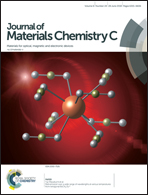Effective thermal transport highway construction within dielectric polymer composites via a vacuum-assisted infiltration method†
Abstract
Materials with superior thermal conduction, stable electrical insulation, and excellent mechanical strength that can be obtained at low cost are desirable for electronic packaging and thermal management in electrical engineering systems. There is therefore relentless interest in developing highly robust thermally conductive and electrically insulating polymer-based composites. Herein, a facile and environmentally friendly method to construct three-dimensional thermal transport channels in a poly(vinyl alcohol) (PVA) matrix composite is reported. The formation of thermal transport highways improves the thermal conductivity up to 4.79 W m−1 K−1 for alumina (Al2O3) loading of 45.4 vol% in the composites. The thermal conductivity achieved is the highest value for this Al2O3 content range compared with reported work, and is 1700% compared with that of pure PVA. In the meantime, the composites still retain outstanding electrical insulation properties and excellent mechanical strength. The heat-conducting and electrically insulating composites not only have promising applications in electronic packaging and electrical engineering systems, but the technically facile vacuum-assisted infiltration method is a new avenue for the mass production of spherical filler/polymer composites.



 Please wait while we load your content...
Please wait while we load your content...